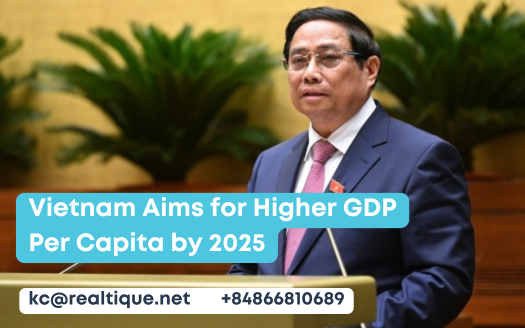Vietnam Aims for Higher GDP Per Capita by 2025
Vietnam’s aspiration for a GDP per capita of approximately $4,900 by 2025 reflects a strategic commitment to raise its economic standing on the global stage. With forecasts indicating a strong GDP growth rate exceeding 7%, the government is prioritizing sustainable development and regulatory enhancements. However, this ambitious path is not without its obstacles, including rising living costs and market pressures that could undermine stability. As Vietnam maneuvers through these intricacies, the implications for its economic environment and the measures taken to address potential pitfalls warrant closer examination.
Table of Contents
Economic Growth Projections
Vietnam’s economic growth projections reflect the government’s ambitious vision for the country’s future. Aiming for a GDP growth rate between 6.5% and 7% by 2025, Vietnam seeks to enhance its GDP per capita to approximately 4,900 USD within the same timeframe.
The current GDP growth forecast for this year exceeds 7%, indicating a strong economic performance. By achieving these targets, Vietnam aspires to position its economy among the 31st to 33rd largest globally.
These growth projections align with strategic economic planning for 2024-2025, focusing on sustainable development and resilience against external economic challenges. The government’s commitment to maintaining this growth path emphasizes its dedication to improving the overall economic environment for its citizens.
Key Government Strategies
To support its ambitious economic growth targets, the government has outlined a series of strategic initiatives aimed at encouraging sustainable development.
These strategies prioritize traditional growth sectors such as exports and domestic consumption while integrating new approaches like green conversion and digital transition.
The government emphasizes enhancing energy efficiency and overcoming challenges in public investment disbursement to stimulate economic activity.
Additionally, regulatory structures are set to be streamlined, nurturing a more conducive environment for business operations.
This varied approach aims to maintain strong growth, targeting a GDP per capita of $4,900 by 2025, positioning Vietnam favorably in the global economy and addressing both current and future economic challenges effectively.
Infrastructure Investment Plans
Significant investments in infrastructure are essential for supporting Vietnam’s economic growth objectives and enhancing overall connectivity. The government has prioritized major projects, including the T3 Terminal at Tan Son Nhat and the T2 Terminal at Noi Bai, aiming to boost transportation capabilities.
By 2025, Vietnam targets the completion of 3,000 km of expressways to facilitate efficient movement of goods and people. Additionally, there is a strong emphasis on upgrading energy infrastructure, particularly in renewable energy sources, to meet growing demands sustainably.
Streamlining regulatory structures will expedite public works, ensuring that essential infrastructure projects are completed on schedule. These initiatives are important for nurturing a strong economy, ultimately contributing to the goal of increasing GDP per capita significantly.
Challenges to Economic Growth
Amidst ambitious growth targets, various challenges loom over Vietnam’s economic terrain. External pressures such as inflation and shifts in global markets threaten to destabilize progress.
Additionally, the business environment is increasingly challenging due to rising operational costs and high levels of corporate debt, leading to liquidity issues for many enterprises.
The alarming trend of business exits, with approximately 163,800 companies leaving the market, further highlights these difficulties.
Consumer purchasing power is stagnating, exacerbated by rising costs of living, which hinders domestic consumption.
Addressing these complex challenges is critical for sustaining economic momentum and achieving the desired GDP per capita growth, as Vietnam aspires to enhance its global economic standing by 2025.
Real Estate Market Dynamics
Vietnam’s real estate market is undergoing a revolutionary phase characterized by rising prices and heightened demand. This energetic environment is driven by vigorous economic growth and urbanization, leading to a significant imbalance between supply and demand. Consequently, housing affordability is becoming a critical issue for many citizens.
| Factor | Current Trend | Impact |
|---|---|---|
| Prices | Increasing by 10% YoY | Reduced affordability |
| Demand | High, especially in urban areas | Speculative investments |
| Housing Supply | Lagging behind demand | Price hikes and shortages |
As the government implements regulatory structures, the market’s stability will hinge on addressing these disparities while encouraging sustainable growth in the real estate sector.





